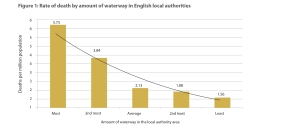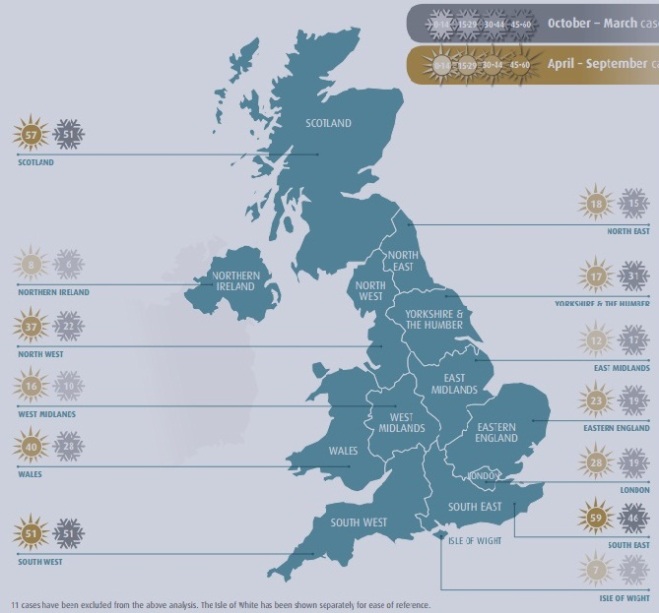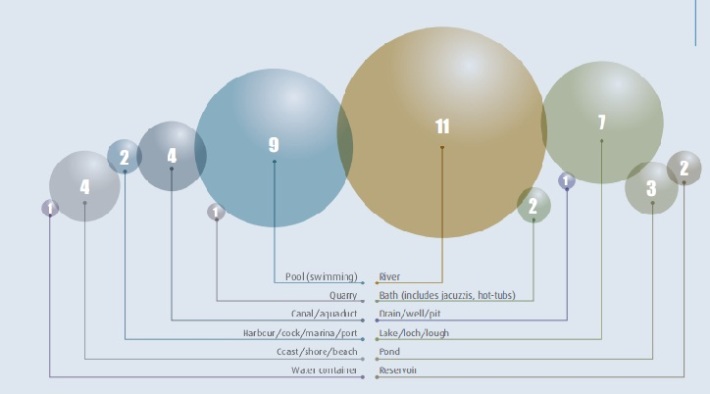The 2012 UK Water related fatalities; Water Incident Database Report has been released!
This report is the first release of WAID fatality information for 2012, and has been compiled by members of the National Water Safety Forum.
We gratefully acknowledge those organisations that have contributed data and special thanks are also extended to the contributing police, fire and rescue services. For further information on the WAID service please see: http://www.nationalwatersafety.org.uk/waid
Previous WAID UK Annual Fatal Incident reports, dating back to 2009 are available on the Forum’s website: http://www.nationalwatersafety.org.uk/waid/reports.asp
MAIB Safety Bulletin 3/2013 – Wacker Quacker 1 / Cleopatra published
Summary: The MAIB has issued Safety Bulletin 3/2013 following the sinking of the DUKW amphibious vehicle Wacker Quacker 1 in Salthouse Dock, Liverpool on 15 June 2013 and the fire on board the DUKW amphibious vehicle Cleopatra on the River Thames, London on 29 September 2013. Issued 28 October 2013. Safety Bulletin 3_2013.pdf (4.38 kb) http://www.maib.gov.uk/cms_resources.cfm?file=/Safety%20Bulletin%203_2013.pdf
Arklow Meadow Accident Investigation Report 21/2013 published
Summary: MAIB Report on the investigation into a release of phosphine gas during cargo discharge on board Arklow Meadow, Warrenpoint, Northern Ireland on 5 December 2012. Report No 21/2013. Published 3 October 2013. View or download the full report: http://www.maib.gov.uk/publications/investigation_reports/2013/arklow_meadow.cfm
mv Amber Accident Investigation Report 22/2013 published
Summary: The MAIB report on the investigation of the contact and grounding of the bulk carrier mv Amber at Gravesend Reach, River Thames on 15 November 2012, was published on 24 October 2013. Report No 22/2013. View or download the full report: http://www.maib.gov.uk/cms_resources.cfm?file=/mvAmber.pdf
Busiest summer in years – Says the RNLI
The RNLI have released provisional figures from over the summer period, showing sharp rises in the number of lifeboat launches across the UK. Across the UK and Republic of Ireland, the charity’s lifeboats launched 4,300 times – the most in 24 years – and lifeguards attended 14,814 Incidents.
Wales – Lifeboat launches across Wales between June – August rocketed by 43 per cent compared with summer 2012. Statistics reveal RNLI lifeboats and lifeguards across Wales have been exceptionally busy, with RNLI lifeguards responding to 946 incidents and RNLI lifeboats launching 726 times. Of the 31 lifeboat stations in Wales, 24 reported an increase in emergency calls with some experiencing dramatic rises. http://rnli.org/NewsCentre/Pages/RNLI-in-Wales-reports-busiest-summer-in-24-years.aspx
Northern Ireland – The lifeboats in Northern Ireland launching 138 times during the months of June, July and August, an increase of 20 per cent on the previous summer. The charity’s lifeguards were also busy on ten beaches with 259 recorded incidents, an increase from 142 incidents in 2012. http://rnli.org/NewsCentre/Pages/RNLI-figures-show-busy-summer-for-Northern-Ireland-lifeboats-and–lifeguards.aspx
Manx Lifeboat – Lifeboat launches across the Isle of Man between June – August rocketed by nearly 50 per cent. Of the five RNLI lifeboat stations on the island, Douglas, Peel and Ramsey have all reported a marked increase in call-outs. The most notable rise has been in services by the island’s all-weather lifeboats which have increased from 13 incidents in 2012 to 26 in 2013. http://rnli.org/NewsCentre/Pages/Rise-in-Manx-lifeboat-launches-as-RNLI-reports-busiest-summer-in-24-years.aspx
East of England – 15 stations in the east coast of England launched a total 319 times between June and August 2013. This represents a very small drop of just 4.7 per cent from the 335 launches recorded in 2012. In addition, the charity’s lifeguards, which operate on 15 beaches in the east of England, were kept busy as they responded to 904 incidents during the 2013 summer season. http://rnli.org/NewsCentre/Pages/A-busy-summer-2013-for-lifeboat-crews-and-lifeguards-in-the-East-of-England.aspx
London’s lifeboat – Statistics from the charity, which runs lifeboats from three bases along the River Thames, show there were a total of 263 separate lifeboat launches between June and August 2013. This is just a handful more than the 253 launches recorded in the same period in 2012. Once again two of the RNLI’s London lifeboat stations were in the top five busiest of all 236 lifeboat stations around the UK and Republic of Ireland. The busiest was Tower station, which operates from a floating pier below Waterloo Bridge. Meanwhile Chiswick station, situated at Corney Reach Pier in the town, was ranked third busiest overall. http://rnli.org/NewsCentre/Pages/Lifesaving-statistics-show-a-busy-summer-2013-for-RNLI-London-lifeboats.aspx
North of England – The charity’s volunteer lifeboat crews carried out 598 rescue launches in June, July and August – a 28.9% increase on the previous year. Only the summers of 2003 (632 launches) and 2009 (634 launches) were busier. RNLI lifeguards also experienced a busy season in the north, dealing with 1,408 incidents compared to 1,143 last summer – a 23.2% increase. http://rnli.org/NewsCentre/Pages/Busy-summer-for-the-RNLIs-lifesavers-in-the-north-of-England.aspx
South-West Region – RNLI teams across the South West have been kept busy this summer, provisional statistics for the period June, July and August show a 24% increase in incidents for RNLI lifeguards, and lifeboat crews attending 652 rescues. RNLI lifeguards dealt with 10,615 incidents across the south west, including water based rescues, major and minor first aids and missing children.http://rnli.org/NewsCentre/Pages/Summer-sunshine-keeps-south-west-RNLI-lifesavers-busy.aspx
Scotland – There were more than five lifeboat launches a day Scotland-wide, during a busy summer for the RNLI’s lifeboats. The total number of launches for June, July and August was 476 across Scotland’s 47 stations, just short of the record-breaking Summer of 2008 when there were 480 launches. There were 440 launches during the 2012 summer.
The busiest station in Scotland was Broughty Ferry with 43 launches for its two boats, compared with 23 the previous year.
http://rnli.org/NewsCentre/Pages/Tobermory-RNLI-is-busiest-all-weather-lifeboat-station-in-Scotland-in-Summer-2011.aspx
Ireland – RNLI volunteer lifeboat crews in Ireland were kept busy this summer, with the charity’s lifeboats launching 571 times during the months of June, July and August. The figure represents an increase of 43 per cent on the previous summer.
http://rnli.org/NewsCentre/Pages/RNLI-figures-show-major-increase-in-Irish-lifeboat-launches-during-busy-summer.aspx





You must be logged in to post a comment.